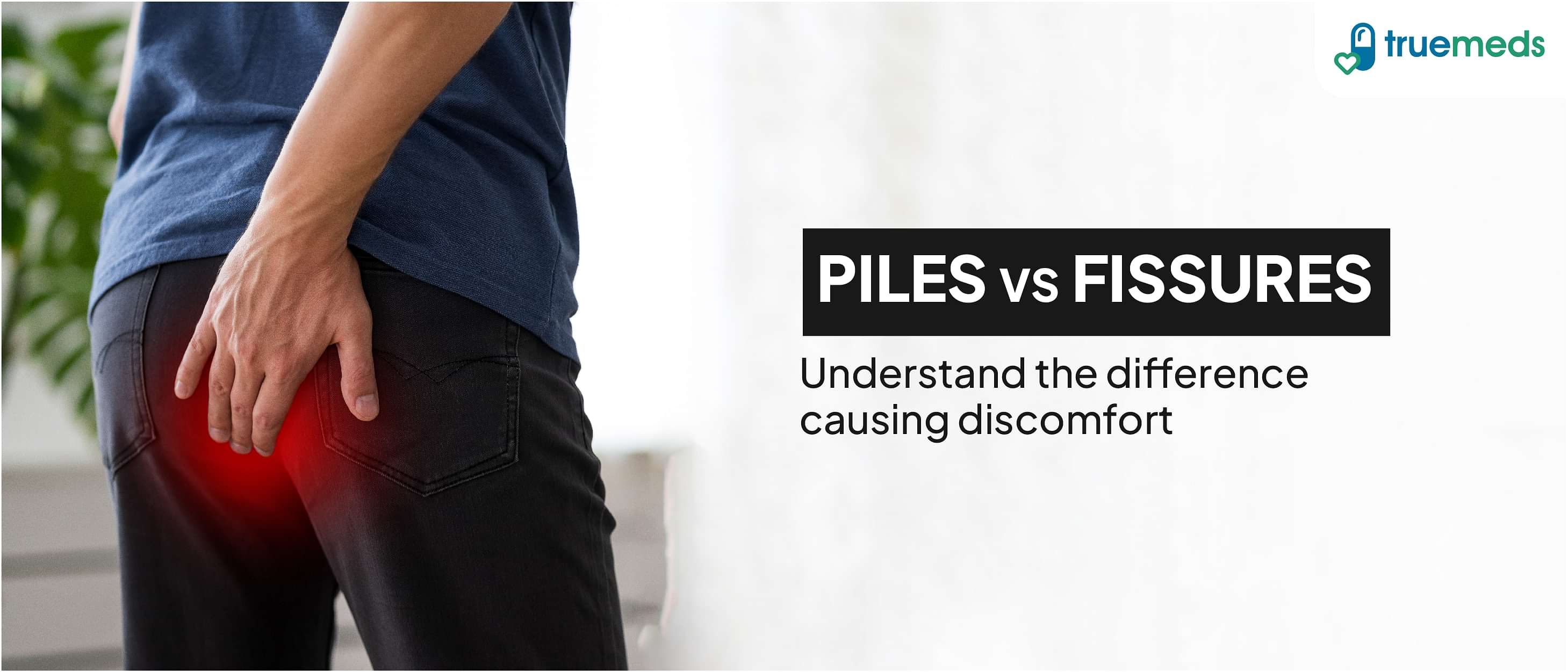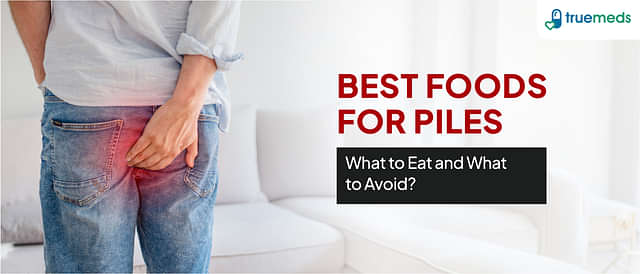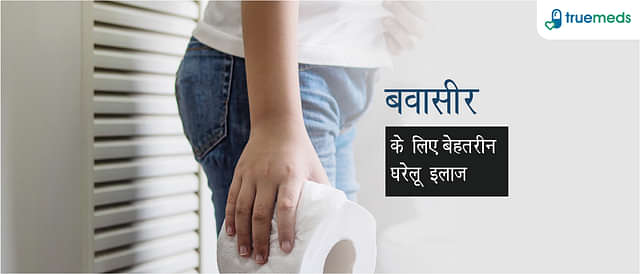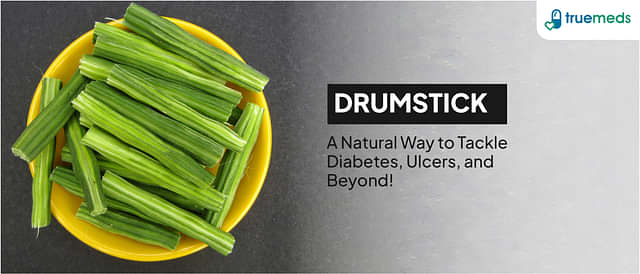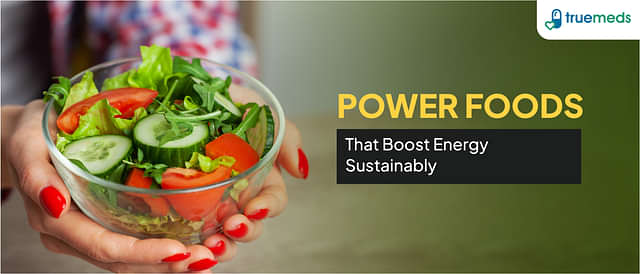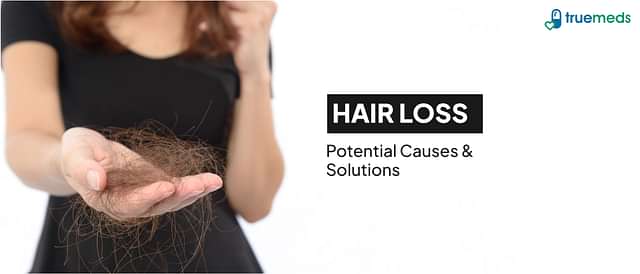The Key Difference Between Piles and Fissures
Last updated on : 17 Mar, 2025
Read time : 11 min
If you’re looking for information on piles and fissures, you’ve come to the right place. Piles and fissures are two types of anal disorders that are often confused. While both conditions can cause discomfort and pain, they are different in terms of their causes, symptoms, and treatments. Both piles and fissures can be treated with lifestyle changes, such as increasing fibre intake and staying hydrated, as well as with medication and surgery in more severe cases. It is essential to seek medical attention if you are experiencing symptoms to determine the appropriate course of treatment. This article will discuss the key difference between piles and fissures so that you can understand these conditions better.
What are Piles?
Piles, also known as haemorrhoids, are a condition where veins in the rectum and anus become swollen and inflamed. They are common and often caused by straining during bowel movements, sitting for long periods, or other factors such as pregnancy. Despite piles being a relatively common issue, many people are embarrassed to speak about them or seek medical attention.
Causes of Piles
- Constipation and prolonged straining during bowel movements are critical factors in causing Piles. (Learn more about the different types of constipation). We can understand the process in the flowchart below.
- According to the World Journal of Gastroenterology, diarrhoea is counted as a risk factor for haemorrhoids. When you strain during a bowel movement or defecation, the symptoms of haemorrhoids aggravate and cause bleeding and protruding of the plexus outwards.
- Pregnancy is a condition that is likely to obstruct the anal cushion and leads to haemorrhoids, but they resolve after birth.
- Dietary factors such as low fibre diet, spicy foods, and alcohol intake have been reported to cause haemorrhoids, but there’s not much evidence.
Types of Haemorrhoids
Piles can be broadly classified into three categories.
Internal haemorrhoids are located inside the rectum, are painless, and tend to bleed.
If you are experiencing rectal bleeding, you will notice bright red blood in your faeces, in the toilet bowl, or on the toilet paper after a bowel movement.
Prolapsed haemorrhoids are a type of external haemorrhoid that has protruded outside of the anus. It occurs when the swollen vein or veins in the haemorrhoid stretch the anus and become displaced.
External haemorrhoids are swollen veins that form outside of the anus. They can cause pain, itching, and discomfort, especially when sitting or having a bowel movement.
Symptoms of haemorrhoids are as follows:
- Anal itching
- You have one or more firm bumps that are tender near your anus.
- Pain in the anal region, mainly when seated
- Your symptoms may worsen if you put too much pressure on your anus and rub or clean it too vigorously.
- The manifestations of external haemorrhoids typically disappear for most people within a few days.
Read Also: Piles (Haemorrhoids) in Women: Symptoms, Causes and Treatment
Complications of haemorrhoids
Haemorrhoids can lead to the following complications:
- Blood clots in an external haemorrhoid.
- Skin tags are the extra skin left behind when a blood clot in an external haemorrhoid heals.
- Infection of a sore on an external haemorrhoid
- Strangulated haemorrhoid, which happens whenever the muscles around your anus cut off the supply of blood to an internal haemorrhoid that has fallen through your anal opening
- Anaemia
Prevention of Piles
Haemorrhoids can be prevented by
- Consuming foods that are high in fibre
- Increasing water intake and other fluids
- Avoiding strain during the bowel movement
- Not spending too much time on the toilet seat
- Not lifting heavy things too often
What is an anal fissure?
Fissures, or anal fissures, are minor cuts or tears in the lining of the anus caused by trauma or straining during a bowel movement. Anal fissures can appear in people of any age; moreover, they are most commonly seen in children and people in the middle years of their lives. Both genders are equally impacted.
Causes of Anal fissures
The following are the causes of Anal fissures.
Types of Anal fissures
Depending upon the severity of the condition, anal fissures can be categorised into
Acute Fissure:
An acute fissure is a small tear in the skin around the anus that has developed recently and is causing symptoms such as pain and bleeding during bowel movements. It is usually caused by trauma to the area, such as passing hard stools or straining during bowel movements. In most cases, acute fissures heal on their own within a few weeks with proper treatment. However, if the fissure persists for more than eight weeks, it may become chronic and require further treatment.
Chronic Fissure
A chronic fissure is a small tear in the skin around the anus that has persisted for more than eight weeks and has not healed on its own. Chronic fissures can cause significant pain and discomfort, and may also result in itching, bleeding, and discharge. They are often caused by underlying conditions such as constipation or inflammatory bowel disease, and may require more aggressive treatment than acute fissures.
Complications of Anal fissures
- Chronic pain: If an anal fissure does not heal properly or is left untreated, it can cause chronic pain and discomfort, significantly impacting a person’s quality of life.
- Infection: If bacteria enters the anal fissure, it can cause an infection, which can be painful and require medical treatment.
- Abscess: An anal abscess can occur if bacteria infect the anal fissure and cause a collection of pus. It can be excruciating and may require surgical drainage.
- Fistula: An anal fistula can occur if an abscess does not heal properly and causes a tunnel between the anus and the surrounding skin. It can cause chronic pain and discomfort and may require surgical treatment. However, there are effective options for fistula treatment without surgery available.
- Incontinence: In rare cases, chronic anal fissures can lead to incontinence, which is the inability to control bowel movements.
Piles vs Fissures
Hemorrhoidal veins, or piles, are enlarged in the anus or lower rectum. Pain, itching, and bleeding during bowel movements are piles symptoms. Numerous things, such as constipation, pregnancy, or obesity, can contribute to them.
Contrarily, fissures are tiny tears in the skin near the anus. They may result from inflammatory bowel disease, persistent diarrhoea, or passing hard stools. Fissures can cause itching, discomfort, bleeding during bowel movements, and other symptoms like pain.
There’s a difference between piles and fissures, according to the symptoms medications can be taken. Changes in diet and lifestyle, along with over-the-counter creams and ointments, are frequently used to treat piles. In addition to sitz baths and other natural remedies, creams or ointments can treat fissures. You might require surgery in some circumstances.
Treatment of Piles and Fissures
Piles and fissures are two common conditions that affect the anal area and can cause pain, discomfort, and bleeding. While these conditions may have different underlying causes, they share some common symptoms, and several medications can relieve the associated discomfort. Even though there is a difference between piles and fissures, there are a few medications that can be used to treat both.
Here are some of the best medicine for piles and fissures:
Painkillers: Painkillers such as ibuprofen or acetaminophen can help to relieve the pain associated with piles and fissures. However, these should be taken only under the guidance of a doctor, as they can have side effects and may interact with other medications.
Topical creams and ointments: Topical creams and ointments are available over-the-counter and can relieve the itching, burning, and pain associated with piles and fissures. They may contain ingredients such as lidocaine, hydrocortisone, or witch hazel, which can help to reduce inflammation and soothe the affected area.
Suppositories: Suppositories are another option for treating piles and fissures. These small, round capsules inserted into the rectum contain medications such as hydrocortisone or zinc oxide, which can help reduce inflammation and relieve pain and itching.
Stool softeners: Stool softeners help relieve constipation by making it easier to pass stool. They draw water into the bowel to soften the stool, making it easier to pass. Stool softeners are available in oral capsules, tablets, and liquids. Docusate sodium, Polyethylene glycol (Miralax), Mineral oil, and Lubricant laxatives.
Nitroglycerin ointment: Nitroglycerin ointment is a medication that can help relax the sphincter muscle and improve blood flow to the anal area, promoting the healing of fissures.
Best Ayurvedic Medicine for Piles and Fissures – Natural and Effective Remedies:
Triphala is a potent Ayurvedic remedy for piles and fissures. It combines three fruits – Amalaki, Bibhitaki, and Haritaki – that have a cleansing effect on the digestive system.
Kutaja is another Ayurvedic herb that is used to treat piles and fissures. It has anti-inflammatory and anti-diarrheal properties that can soothe the digestive system and reduce inflammation and pain.
Arshonyt Forte Tablets are a powerful Ayurvedic remedy that can help treat piles and fissures. They contain natural ingredients like Neem, Haridra, and Daruharidra that have anti-inflammatory, antibacterial, and anti-fungal properties. Arshonyt Forte Tablets can help reduce inflammation and pain, heal wounds, and promote healthy digestion.
Anovate Cream is a natural Ayurvedic cream containing natural ingredients like Haritaki, Neem, and Jatyadi Oil can reduce inflammation, soothe the skin, and promote healing. Anovate Cream can be applied topically to the affected area for quick relief.
Kachnaar Guggulu is an Ayurvedic medicine for treating piles and fissures. It contains natural ingredients like Kachnaar Bark, Amalaki, and Haritaki that can help detoxify the digestive system, reduce inflammation, and promote healing. Kachnaar Guggulu can help relieve constipation, a common cause of piles and fissures. Even though there is a difference between piles and fissures, certain ayurveda medicines treat both.
Conclusion
Piles and fissures are two common medical conditions affecting the anal region. But one should know the difference between piles and fissures to seek medical help. It is essential to get medical attention if you experience symptoms of piles or fissures, as these conditions can be effectively treated with proper diagnosis and treatment. Additionally, practising good anal hygiene and maintaining healthy habits can help prevent the development of these conditions. You can order branded and generic medicines by uploading your prescription on the Truemeds app. When you order pills online, you can save money by choosing an alternative or generic drug that the experts at Truemeds recommend. Save up to 72% on your purchase and get free home delivery across India.
Frequently Asked Question (FAQs)
Mild piles and fissures can go away independently, but severe cases may require treatment.
There is a difference between piles and fissures, which are usually diagnosed through a physical examination and medical history. In some cases, a rectal exam or colonoscopy may be necessary.
Divya Arshkalp Vati, Divya Abhayarishta, Divya Triphala Churna, Divya Arshkalp Kwath, and Divya Panchasav are some of the Patanjali medicines for fissures and piles that you can take.
Disclaimer: This information shouldn’t be used to diagnose or treat a medical condition or be used in a medical emergency. You must consult a qualified medical professional should be consulted to diagnose and treat all medical conditions.
Disclaimer
Our healthcare experts have carefully reviewed and compiled the information presented here to ensure accuracy and trustworthiness. It is important to note that this information serves as a general overview of the topic and is for informational purposes only. It is not intended to diagnose, prevent, or cure any health problem. This page does not establish a doctor-patient relationship, nor does it replace the advice or consultation of a registered medical practitioner. We recommend seeking guidance from your registered medical practitioner for any questions or concerns regarding your medical condition.
Popular Articles
Recommended Articles
Recent Articles
Top-Selling Medicines:
...View more
Top-Selling OTC:
...View more
Company
About UsHealth ArticleHealth StoriesDiseases & Health ConditionsAll MedicinesAll BrandsNeed HelpFAQSubscribe
Registered Office Address
Grievance Officer
Download Truemeds

Contact Us
Our customer representative team is available 7 days a week from 9 am - 9 pm.
v3.7.10
Our Payment Partners









